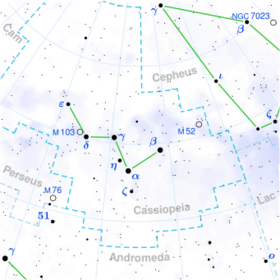Astronomy:12 Cassiopeiae
From HandWiki
Short description: Star in the constellation Cassiopeia
| Observation data Equinox J2000.0]] (ICRS) | |
|---|---|
| Constellation | Cassiopeia |
| Right ascension | 00h 24m 47.5055s[1] |
| Declination | +61° 49′ 51.808″[1] |
| Apparent magnitude (V) | +5.377[2] |
| Characteristics | |
| Spectral type | B9III[3] |
| U−B color index | −0.16[4] |
| B−V color index | +0.00[4] |
| Astrometry | |
| Radial velocity (Rv) | −1.76±0.60[1] km/s |
| Proper motion (μ) | RA: +14.126[1] mas/yr Dec.: −2.715[1] mas/yr |
| Parallax (π) | 3.8102 ± 0.0612[1] mas |
| Distance | 860 ± 10 ly (262 ± 4 pc) |
| Absolute magnitude (MV) | −1.27[5] |
| Details | |
| Mass | 3.1[6] M☉ |
| Radius | 5.7[7] R☉ |
| Luminosity | 386[7] L☉ |
| Surface gravity (log g) | 2.94[6] cgs |
| Temperature | 10,728[7] K |
| Metallicity [Fe/H] | −0.96[6] dex |
| Rotational velocity (v sin i) | 155[8] km/s |
| Age | 257[9] Myr |
| Other designations | |
| Database references | |
| SIMBAD | data |
12 Cassiopeiae (12 Cas) is a white giant in the constellation Cassiopeia, about 860 light years away. It has an apparent magnitude of 5.4, so it faintly visible to the naked eye.
The spectrum of 12 Cassiopeiae is classified as a B9-type giant. About three times as massive as the Sun and 386 times as luminous, it has expanded away from the main sequence after exhausting its core hydrogen. It now has a radius of 5.7 R☉ with an effective temperature of about 10,728 K, leading to a bolometric luminosity of 386 L☉.
References
- ↑ 1.0 1.1 1.2 1.3 1.4 1.5 Vallenari, A. et al. (2022). "Gaia Data Release 3. Summary of the content and survey properties". Astronomy & Astrophysics. doi:10.1051/0004-6361/202243940 Gaia DR3 record for this source at VizieR.
- ↑ Høg, E.; Fabricius, C.; Makarov, V. V.; Urban, S.; Corbin, T.; Wycoff, G.; Bastian, U.; Schwekendiek, P. et al. (2000). "The Tycho-2 catalogue of the 2.5 million brightest stars". Astronomy and Astrophysics 355: L27. doi:10.1888/0333750888/2862. Bibcode: 2000A&A...355L..27H.
- ↑ Cowley, A. et al. (April 1969), "A study of the bright A stars. I. A catalogue of spectral classifications", Astronomical Journal 74: 375–406, doi:10.1086/110819, Bibcode: 1969AJ.....74..375C
- ↑ 4.0 4.1 The Bright Star Catalogue. New Haven: Yale University Observatory. 1991. Bibcode: 1991bsc..book.....H.
- ↑ Anderson, E.; Francis, Ch. (May 2012). "XHIP: An extended hipparcos compilation". Astronomy Letters 38 (5): 331–346. doi:10.1134/S1063773712050015. ISSN 1063-7737. Bibcode: 2012AstL...38..331A.
- ↑ 6.0 6.1 6.2 Anders, F.; Khalatyan, A.; Chiappini, C.; Queiroz, A. B.; Santiago, B. X.; Jordi, C.; Girardi, L.; Brown, A. G. A. et al. (2019). "Photo-astrometric distances, extinctions, and astrophysical parameters for Gaia DR2 stars brighter than G = 18". Astronomy and Astrophysics 628: A94. doi:10.1051/0004-6361/201935765. Bibcode: 2019A&A...628A..94A.
- ↑ 7.0 7.1 7.2 Stassun, Keivan G.; Oelkers, Ryan J.; Pepper, Joshua et al. (20 August 2018). "The TESS Input Catalog and Candidate Target List". The Astronomical Journal 156 (3): 102. doi:10.3847/1538-3881/aad050. Bibcode: 2018AJ....156..102S.
- ↑ Zorec, J.; Royer, F. (January 2012). "Rotational velocities of A-type stars IV: Evolution of rotational velocities". Astronomy & Astrophysics 537: A120. doi:10.1051/0004-6361/201117691. ISSN 0004-6361. Bibcode: 2012A&A...537A.120Z.
- ↑ Gontcharov, G. A. (December 2012). "Dependence of kinematics on the age of stars in the solar neighborhood". Astronomy Letters 38 (12): 771–782. doi:10.1134/S1063773712120031. ISSN 1063-7737. Bibcode: 2012AstL...38..771G.
 |


